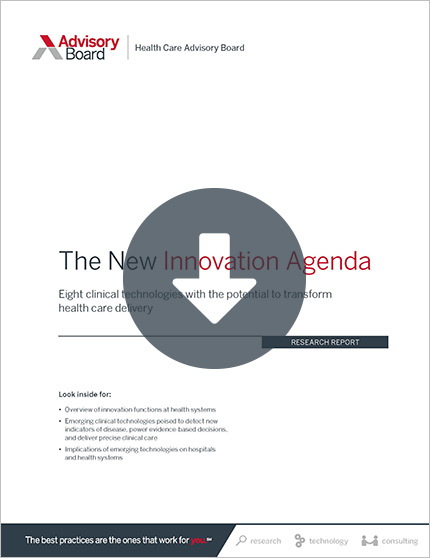How do leading health systems foster a culture of innovation? Executives from Cleveland Clinic, UPMC, and Rush University Medical Center in a recent interview with Healthcare Finance News' Beth Jones Sanborn shared their seven secrets to innovation.
1. Identify strong innovators
When looking for innovators, don't limit the search to people working IT and clerical roles, the executives said.
Cleveland Clinic Associate CIO Will Morris said, "An innovator to me is someone who is perpetually dissatisfied with the status quo," Morris. He added that innovators do not always propose new ideas or solutions, but they "can articulate and understand the core problem," he said.
To find the innovators within an organization, you shouldn't limit the search to people working IT and clerical roles, the executives said.
Instead, Rush University Medical Center CIO Shafiq Rab said innovation should be imbedded in all aspects of the organization's culture. "We believe that every employee, staff, doctor, and nurse has an idea," Rab said.
2. Innovate with a purpose
With the development of new technology, it is easy for hospitals to be drawn to the newest gadgets. But, Rasu Shrestha, CIO of UPMC, explained that successful innovation requires more than new tech.
According to the executives, a hospital's innovative strategy should be "purpose-driven," conceivable, and adaptable, Jones Sanborn reports. Hospitals should consider all opportunities for innovation, Shrestha said, regardless of how appealing or modern some technologies might seem. It then becomes your role to highlight any "expertise in a specific area that distinguishes" the health system, Shrestha said.
3. Find innovation in an unlikely place
While provider and clinical innovation often grab the spotlight, the executives said it's important not to overlook the "'unsexy side" of health care innovation hiding in the backend. In fact, three quarters of innovation in the health care sector are operational, including HR, billing, and procurement, Jones Sanborn reports.
"It is a veritable goldmine to disrupt the back office functions," Morris said.
4. Invest wisely
However, when investing in new technology to disrupt any department, Rab said it's important to invest incrementally.
Before you begin investing, Rab explained that leaders should establish the problem they are trying to solve with innovation and the value of solving that problem—especially if it can provide value to other hospitals.
"These are the mechanisms by which you self-protect," Rab said "You don't have to invent yourself but you can invite other people to use your space as a collaboratory. From that you can profit and benefit."
5. Get end-users involved
If a hospital neglects to involve end-users when designing a new product, it can be difficult, or impossible, to detect an issue before the product is fully built, Jones Sanborn reports. In these cases "the first time you hit a roadblock, hiccup or failure, if you're not thinking long-term then chances are that project is going to get scrapped," Shrestha said.
To avoid crashing and burning in the end stages, hospitals should recruit front line staff as end users to ensure new products can be smoothly integrated into the existing workflow. "The front line people are so key. They are the first mile and the last mile of innovation. They are the ones who see the reality, who are actually going to adopt it and use it and show value," Morris said.
6. Make workflow a key component to any innovation plans
Understanding the workflow is essential to fully fleshing out a problem and solving it effectively. If innovators don't consider workflow, adoption is unlikely, Morris said. "Often we see really cool widgets or devices or things. But if they aren't integrated in a meaningful workflow they'll never be adopted."
7. Think outside the box—and the industry
Chances are, if one hospital spots an opportunity for innovation and improvement, other hospitals or industries have come across the same problem, Jones Sanborn reports. If health care providers collaborate with organizations outside the health care industry, they might find that their problem has already been solved.
With this in mind, Morris advised, "Look outside the industry for inspiration." He added, "When you open up your apertures, the world is a ripe place for disruption and healthcare can be a tremendous benefactor" (Jones Sanborn, Healthcare Finance News, 9/11).
Upcoming webconference series: How to build a differentiated culture
Hospitals and health systems have never been more committed to attracting, inspiring and retaining the talent they need. Yet, with limited resources and heightened competition for talent, leaders are increasingly asking what else can be done. In this three-part series, we’ll explore one approach that can help achieve all three objectives—building a differentiated organizational culture.
- Thursday, Oct. 11 | Six levers that can shift your culture from default to differentiated
- Thursday, Oct. 25 | Use talent management to advance your desired culture
- Thursday, Nov. 1 | Leverage key influencers to advance your desired culture
Don't miss out on the latest Advisory Board insights
Create your free account to access 1 resource, including the latest research and webinars.
Want access without creating an account?
You have 1 free members-only resource remaining this month.
1 free members-only resources remaining
1 free members-only resources remaining
You've reached your limit of free insights
Become a member to access all of Advisory Board's resources, events, and experts
Never miss out on the latest innovative health care content tailored to you.
Benefits include:
You've reached your limit of free insights
Become a member to access all of Advisory Board's resources, events, and experts
Never miss out on the latest innovative health care content tailored to you.
Benefits include:
This content is available through your Curated Research partnership with Advisory Board. Click on ‘view this resource’ to read the full piece
Email ask@advisory.com to learn more
Click on ‘Become a Member’ to learn about the benefits of a Full-Access partnership with Advisory Board
Never miss out on the latest innovative health care content tailored to you.



